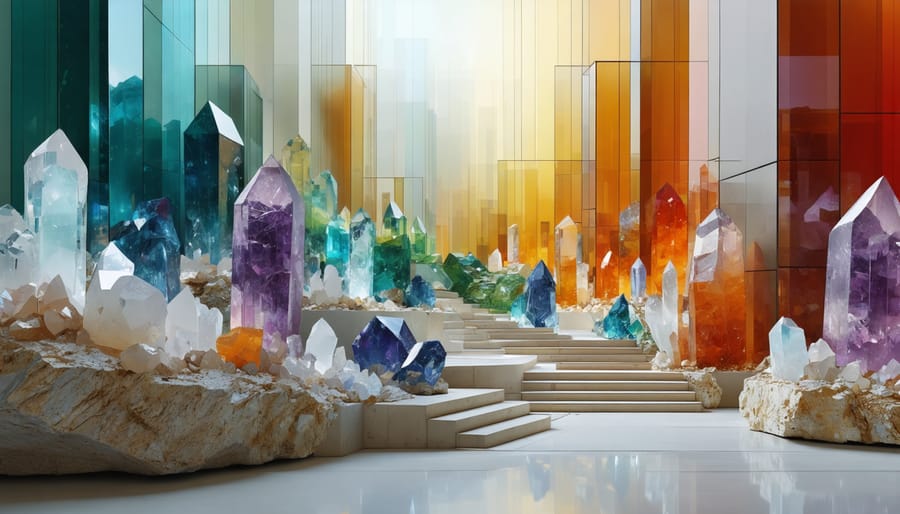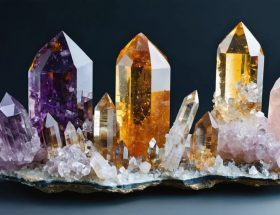Minerals shape the very foundation of our built environment, transforming from microscopic crystals into the magnificent stone surfaces that define modern architecture. Deep within the Earth’s crust, complex geological processes forge an astounding variety of minerals – each with unique properties that determine a stone’s durability, appearance, and performance. Understanding mineral geology unlocks crucial insights for anyone working with natural stone, from the precise arrangement of atoms that creates marble’s legendary luster to the interlocking crystal structures that give granite its remarkable strength. This marriage of science and aesthetics helps architects and designers make informed decisions about stone selection, ensuring the right material for every application. Whether examining a gleaming countertop or a towering stone facade, the story begins with minerals – nature’s building blocks that continue to shape our world millions of years after their formation.
The Building Blocks of Natural Stone
Essential Rock-Forming Minerals
The essential rock-forming minerals play a crucial role in determining the characteristics and quality of natural stone. Quartz, one of the most abundant minerals, provides hardness and durability to stones like granite and sandstone. Feldspar minerals, including plagioclase and orthoclase, contribute to the diverse color variations seen in many natural stones and make up nearly 60% of Earth’s crust.
Mica minerals, particularly biotite and muscovite, appear as flat, sheet-like crystals that add sparkle and character to stones like granite. Their presence can influence how the stone splits or cleaves. Other significant minerals include amphiboles and pyroxenes, which often appear as dark, elongated crystals in many igneous and metamorphic rocks.
These minerals combine in various proportions to create the distinct patterns, colors, and physical properties that make each natural stone unique. Understanding their presence helps predict how different stones will perform in various applications, from countertops to building facades.
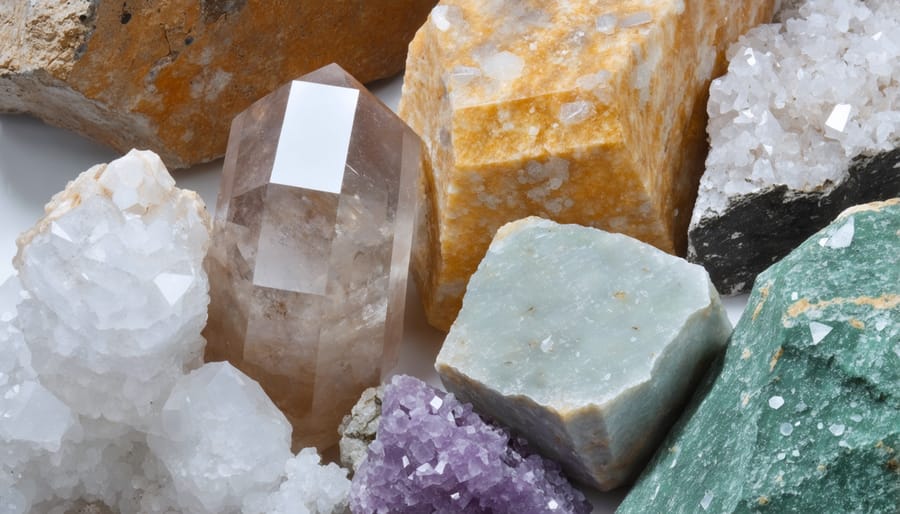
How Minerals Define Stone Properties
The mineral composition of natural stone directly influences its key physical properties, making each type uniquely suited for different applications. Minerals determine a stone’s hardness through their crystal structure and chemical bonds. For example, granite’s high quartz content gives it exceptional hardness and scratch resistance, while the calcite in marble creates a softer, more workable material.
Durability is also mineral-dependent. Stones rich in stable minerals like quartz and feldspar resist weathering and chemical exposure better than those containing more reactive minerals. This explains why granite maintains its appearance longer than limestone when exposed to acidic rain or harsh cleaning products.
The visual characteristics of stone – color, pattern, and texture – stem from its mineral makeup. White marble gets its classic look from pure calcite crystals, while the dramatic speckles in granite come from various mineral combinations of quartz, feldspar, and mica. Even the way stone reflects light depends on its mineral composition, with some creating subtle sparkles and others displaying a smooth, matte finish.
Understanding these mineral-based properties helps professionals and homeowners choose the right stone for their specific needs, ensuring both aesthetic satisfaction and long-term performance.
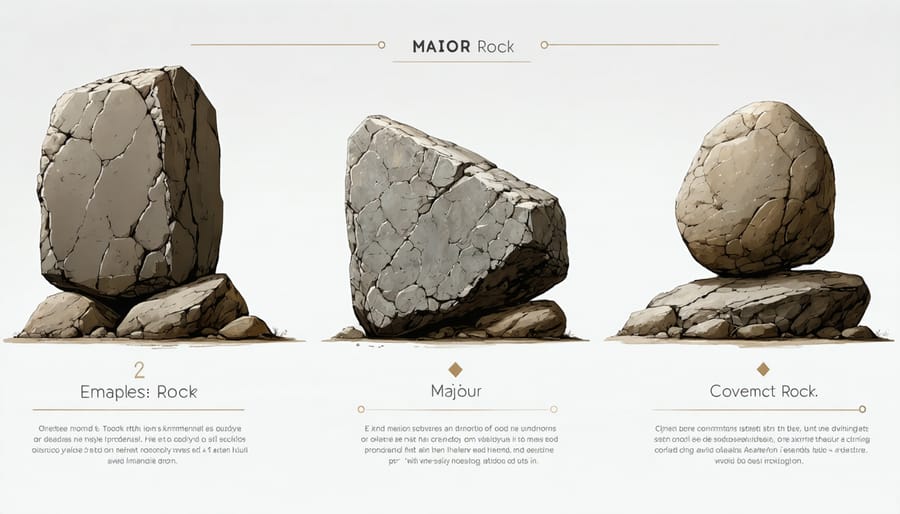
Formation Processes and Mineral Evolution
Igneous Origins
Deep beneath the Earth’s surface, intense heat and pressure create the foundation for igneous rocks through a fascinating process of magma crystallization. As molten rock cools slowly within the Earth’s crust, minerals gradually separate and form distinct crystals. This process gives birth to stones like granite, which showcase a characteristic speckled appearance due to various mineral crystals interlocking during formation.
The cooling rate significantly influences the final appearance and structure of igneous stones. Slower cooling allows larger crystals to form, resulting in stones with visible mineral grains, like the ones found in granite. In contrast, rapid cooling produces smaller crystals or even glassy textures, as seen in obsidian.
The mineral composition during crystallization determines the stone’s color, durability, and physical properties. For example, granite’s strength comes from its high quartz and feldspar content, while the presence of minerals like hornblende or biotite creates its distinctive dark specks. Understanding these igneous origins helps explain why certain stones exhibit particular characteristics and perform differently in various applications.
This natural formation process creates stones that are not only beautiful but also incredibly durable, making them ideal for both decorative and functional uses in construction and design.
Metamorphic Transformations
Deep within the Earth’s crust, extraordinary transformations occur as existing rocks and minerals undergo intense pressure and heat, creating entirely new stone varieties through a process called metamorphism. This natural phenomenon is responsible for some of our most prized architectural stones, including marble and slate.
When limestone experiences intense heat and pressure, it transforms into marble through recrystallization. During this process, the original calcium carbonate minerals realign and interlock, creating marble’s characteristic crystalline structure and distinctive veining patterns. This metamorphic process can also incorporate other minerals, resulting in the wide array of colors and patterns that make each marble piece unique.
Similarly, slate forms when clay-rich sedimentary rocks, such as shale, are subjected to moderate heat and pressure. The clay minerals realign perpendicular to the pressure direction, creating slate’s trademark ability to split into thin, durable layers. This property has made slate a popular choice for roofing and flooring applications throughout history.
The specific conditions during metamorphism, including temperature, pressure, and duration, determine the final characteristics of the stone, influencing its durability, appearance, and suitable applications in construction and design.
Sedimentary Development
Sedimentary rocks like limestone and sandstone form through a fascinating process of mineral deposition over millions of years. These rocks begin as loose particles – either fragments of other rocks, chemical precipitates, or organic remains – that gradually accumulate in layers within bodies of water or on land.
In the case of limestone, calcium carbonate minerals primarily derive from marine organisms like corals and shellfish. As these creatures die, their mineral-rich shells and skeletons settle on the ocean floor. Over time, these deposits compact under their own weight while mineral-rich waters percolate through them, cementing the particles together through a process called lithification.
Sandstone follows a similar development pattern but starts with sand grains, typically composed of quartz minerals. These grains accumulate in ancient beaches, deserts, or river beds. As layers build up, pressure from above forces the grains closer together while minerals carried by groundwater act as natural cement, binding the particles into solid rock.
The specific conditions during formation – including water chemistry, temperature, pressure, and time – determine the final characteristics of the stone. This explains why limestone can range from soft and chalky to dense and crystalline, while sandstone varies in color, hardness, and grain size. Understanding these formation processes helps professionals select the right stone for specific applications, as the depositional environment directly influences durability and appearance.
Color and Pattern Development
Mineral-Based Coloration
The vibrant colors found in natural stone are directly attributed to their mineral composition, creating distinctive mineral-based coloration patterns that make each piece unique. Iron-bearing minerals typically produce reds, browns, and yellows, with hematite creating deep red hues and limonite contributing golden-yellow tones. The presence of chlorite and serpentine minerals results in various green shades, while copper minerals like malachite and azurite create striking blue-green colorations.
White and gray tones commonly appear due to calcite and dolomite, particularly prevalent in marble and limestone. Black coloration often stems from graphite or manganese minerals, while purple hues typically indicate the presence of fluorite. The depth and intensity of these colors can vary based on mineral concentration and formation conditions.
Some minerals create spectacular visual effects beyond basic coloration. For instance, mica produces a shimmering effect, while quartz can create a glass-like luster. Multiple minerals may combine within a single stone, creating complex patterns and color variations. Understanding these mineral-color relationships is crucial for architects and designers when selecting natural stone for specific aesthetic requirements, as mineral composition not only determines appearance but also influences the stone’s durability and performance characteristics.
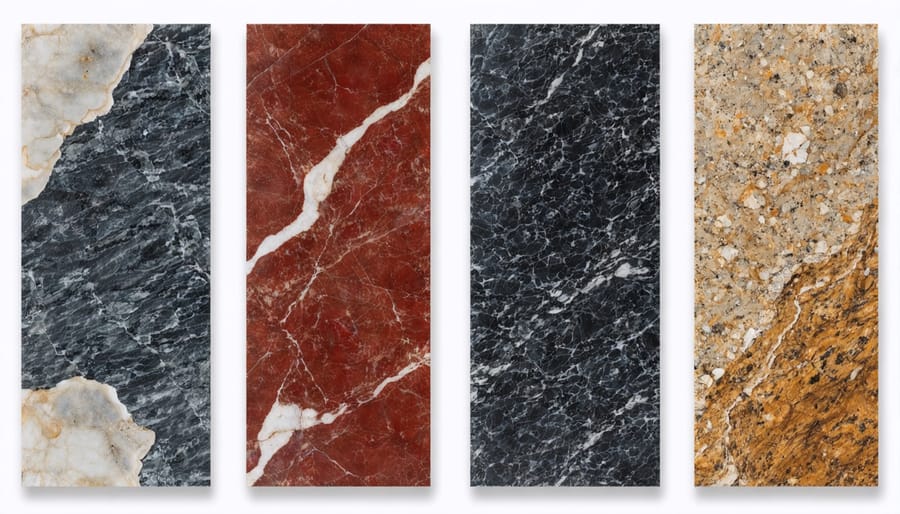
Pattern Formation
Natural stone formations exhibit fascinating patterns that tell the story of their geological history. Among the most common patterns are veining and banding, which occur through distinct mineral crystallization processes over millions of years. Veining typically forms when mineral-rich solutions fill cracks and fissures in existing rock, creating intricate networks of contrasting colors and textures. These patterns are particularly prominent in marble and quartzite, where white calcite or quartz veins often traverse through darker base material.
Banding occurs when different minerals crystallize in alternating layers, creating parallel or undulating stripes throughout the stone. This pattern is commonly seen in gneiss and certain varieties of marble, where pressure and temperature changes during metamorphism cause minerals to separate into distinct bands. The width and regularity of these bands can vary significantly, from microscopic layers to prominent stripes several inches wide.
Other notable patterns include orbicular formations, where minerals crystallize in concentric circles, and dendritic patterns that resemble plant-like branches. These formations often result from trace minerals crystallizing within fractures or along grain boundaries. Understanding these patterns is crucial for stone selection in design applications, as they significantly impact the visual character of the finished surface and can influence how the stone is cut and installed to achieve the desired aesthetic effect.
Practical Applications in Stone Selection
Durability Considerations
The mineral composition of natural stone directly influences its durability and suitability for various applications. Quartz-rich stones, such as granite, typically demonstrate superior hardness and resistance to scratching, making them ideal for high-traffic areas and kitchen countertops. These stones score between 6 and 7 on the Mohs hardness scale, ensuring long-term performance under demanding conditions.
Calcite-based stones like marble and limestone, while beautiful, are more susceptible to acid etching and wear. Their softer mineral structure (3-4 on the Mohs scale) requires more careful consideration in application and maintenance, particularly in areas exposed to acidic substances or heavy use.
The presence of mica minerals can affect a stone’s structural integrity, as these minerals form in sheets that may separate over time, especially when exposed to moisture or temperature fluctuations. This characteristic is particularly important when selecting stone for exterior applications or wet environments.
Feldspars, common in granite and other igneous rocks, contribute to the stone’s overall strength and resistance to weathering. However, some feldspar varieties can undergo chemical weathering when exposed to acidic rain or harsh environmental conditions.
Understanding these mineral relationships helps in making informed decisions about stone selection. For example, a quartz-rich granite would be more suitable for an outdoor kitchen, while a calcite-based marble might be better reserved for interior wall cladding or decorative elements with limited exposure to harsh conditions.
Maintenance Requirements
The mineral composition of natural stone directly influences its stone maintenance requirements and long-term durability. Stones rich in calcite, like marble and limestone, are more sensitive to acidic substances and require regular sealing to prevent etching and staining. These materials need pH-neutral cleaners and immediate attention to spills to maintain their appearance.
Granite, composed primarily of quartz and feldspar, exhibits greater resistance to acids and scratching, making it easier to maintain. However, its porosity still necessitates periodic sealing to prevent staining, particularly in lighter varieties. Quartzite, with its high quartz content, offers exceptional durability and requires minimal maintenance beyond routine cleaning.
The presence of iron-bearing minerals can affect maintenance protocols, as these compounds may oxidize when exposed to moisture, potentially causing rust-like discoloration. Regular sealing helps prevent this issue, particularly in outdoor applications.
Understanding these mineral-based characteristics helps property owners and facility managers develop appropriate maintenance schedules and select suitable cleaning products. For example, stones with mica content may show enhanced luster with proper care but can become dull if treated with abrasive cleaners. Regular assessment of the stone’s condition and adherence to material-specific care guidelines ensures optimal preservation of its natural beauty and structural integrity.
Understanding mineral geology is fundamental to making informed decisions about natural stone selection and application. The intricate relationship between mineral composition and a stone’s physical properties directly impacts its performance, durability, and aesthetic appeal in various architectural and design applications.
By studying mineral geology, we gain valuable insights into how different stones will respond to environmental conditions, wear patterns, and various treatment methods. This knowledge enables architects, designers, and homeowners to select materials that not only meet their aesthetic preferences but also perform optimally in their intended applications.
The mineral composition of natural stone influences everything from its color and pattern to its hardness and resistance to weathering. This understanding helps predict how different stones will age, what maintenance requirements they’ll have, and how they’ll perform in specific environments – whether it’s a high-traffic commercial floor or an outdoor kitchen countertop.
Moreover, mineral geology helps us appreciate the unique character of natural stone. Each piece tells a story of geological processes spanning millions of years, making it not just a building material but a piece of Earth’s history. This deeper understanding enhances our ability to work with natural stone’s inherent properties rather than against them, leading to more successful and sustainable applications.
As we continue to innovate in architecture and design, this geological knowledge remains crucial for pushing the boundaries of natural stone applications while ensuring longevity and performance.

